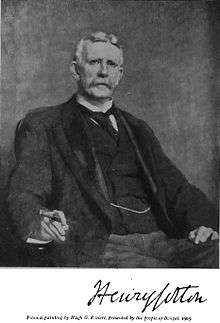Henry John Stedman Cotton
| Sir Henry John Stedman Cotton | |
|---|---|
 Portrait of Sir Henry Cotton | |
| Born |
13 September 1845 Kumbakonam |
| Died | 22 October 1915 |
| Occupation | Civil servant, Member of Parliament, author |
| Spouse(s) | Mary, Lady Cotton (née Ryan) |

Sir Henry John Stedman Cotton, KCSI (13 September 1845 – 22 October 1915)[1] had a long career in the Indian Civil Service, during which he was sympathetic to Indian nationalism. After returning to England, he served as a Liberal Party Member of Parliament (MP) for Nottingham East from 1906 to January 1910.
Early life
Cotton was born in 1845 in the city of Kumbakonam in the Madras region of India, to Indian-born parents of English descent, Joseph John Cotton (1813-1867) and Susan Jessie Minchin (1823-1888). Through his paternal great-grandfather Joseph Cotton (1746–1825), Henry John Stedman Cotton was a first cousin once removed of both the judge Henry Cotton (his godfather, who he was named after[2]) and of the African explorer William Cotton Oswell.[3][4]
In 1848, he left India to be educated in England. He entered Magdalen College School in 1856, Brighton College in 1859, and King's College London in 1861. After his graduation from college, he took and passed the Indian Civil Service Examination.
Career
Cotton joined the Indian Civil Service, arriving in India in 1867. His first posting was at Midnapore, where his immediate superior was William James Herschel, then the local magistrate. His eldest son H. E. A. Cotton was born in that city in 1868.[2] He later served in Chuadanga, where he witnessed the great flood of 1871. In 1872 he was posted to Calcutta, and in 1873 he was appointed Assistant Secretary to the Bengal Government by Sir George Campbell, and later worked under Sir Richard Temple. In 1878 he became magistrate and collector at Chittagong; in 1880 he became Senior Secretary to the Board of Revenue in Bengal. He later became Revenue Secretary to Government, Financial and Municipal Secretary, and then a member of the Bengal Legislative Council.
Cotton eventually rose to be Chief Commissioner of Assam (1896 to 1902), during which time he experienced the 1897 Assam earthquake. Cotton College, Guwahati was established by him in 1901.
Cotton supported Indian Home Rule and got into serious trouble when he advocated the cause in his 1885 book New India, or India in Transition (revised edition 1907). In 1904, he served as President of the Indian National Congress, one of the few non-Indians to do so.[5] As such, he led the opposition to Curzon's invasion of Tibet and partition of Bengal.
On his return to England, Cotton was elected Liberal Party Member of Parliament (MP) for Nottingham East in 1906. There he formed a radical pro-Indian parliamentary group, and criticised his own government's actions in India. Already in poor health, he was narrowly defeated in his attempt for re-election in 1910.
Personal life

In 1867 in Freshwater, Isle of Wight, Cotton married Mary Ryan (1848-1914). They had four children: Sir Harry Evan Auguste Cotton (1868-1939), Julian James Cotton (1869-1927), Mary Cotton (b. 1873), and Albert Louis Cotton (1874-1936).[6] Cotton met and married Ryan having seen a picture of her taken by pioneering photographer Julia Margaret Cameron. Ryan had been partly raised by Cameron, who found her as a child begging on Putney Heath.[7] The couple were photographed together by Cameron, in costume as Romeo and Juliet, on their wedding day.
Two of his sons, H.E.A. Cotton and Julian James, also made careers in the civil service in India. Cotton's grandson, Sir John Cotton (1909-2002), was Ambassador to the Congo Republic and Burundi and the last of six generations of Cottons to serve in colonial administration in India.[8]
He was an active writer and activist on behalf of Indian rights until the end of his life, despite ill health and financial difficulties. In 1911 he published his memoirs, Indian and Home Memories. Sir Henry Cotton died at his home in St John's Wood, London, in October 1915.
References
- ↑ "Historical list of MPs: constituencies beginning with "N", part 3". Leigh Rayment's House of Commons pages. Retrieved 8 January 2010.
- 1 2 Sir Henry Cotton (1911). Indian & Home Memories. London: T. Fisher Unwin. Retrieved 2011-02-20.
- ↑ "Relationship Calculator: Henry John Stedman Cotton relationship to Henry Cotton". Halhed genealogy & family trees. Retrieved 2011-02-19.
- ↑ "Relationship Calculator: Henry John Stedman Cotton relationship to William Cotton Oswell". Halhed genealogy & family trees. Retrieved 2011-02-19.
- ↑ "Indian National Congress Session and its President". AICC, New Delhi. Archived from the original on 2009-04-08. Retrieved 24 February 2010.
- ↑ "Henry John Stedman Cotton 1845 - 1915". Halhed genealogy & family trees. Retrieved 2011-02-19.
- ↑ Higgins, Charlotte (22 September 2015). "Julia Margaret Cameron: soft-focus photographer with an iron will". The Guardian. Retrieved 25 July 2016.
- ↑ "Obituary: Sir John Cotton". The Telegraph. Retrieved 25 July 2016.
External links
- Hansard 1803–2005: contributions in Parliament by Edward Bond
| Government offices | ||
|---|---|---|
| Preceded by William Erskine Ward |
Chief Commissioner of Assam 1896–1902 |
Succeeded by Sir Joseph Bampfylde Fuller |
| Parliament of the United Kingdom | ||
| Preceded by Edward Bond |
Member of Parliament for Nottingham East 1906 – January 1910 |
Succeeded by James Archibald Morrison |